Artificial Intelligence has evolved from simple computer programs to sophisticated systems capable of autonomous decision-making and learning. At the heart of this transformation are AI agents—intelligent software entities that can perceive their environment, process information, and take actions to achieve specific goals. Understanding the different type of AI agents is crucial for businesses and developers looking to implement intelligent automation solutions that can adapt, learn, and operate with minimal human intervention.
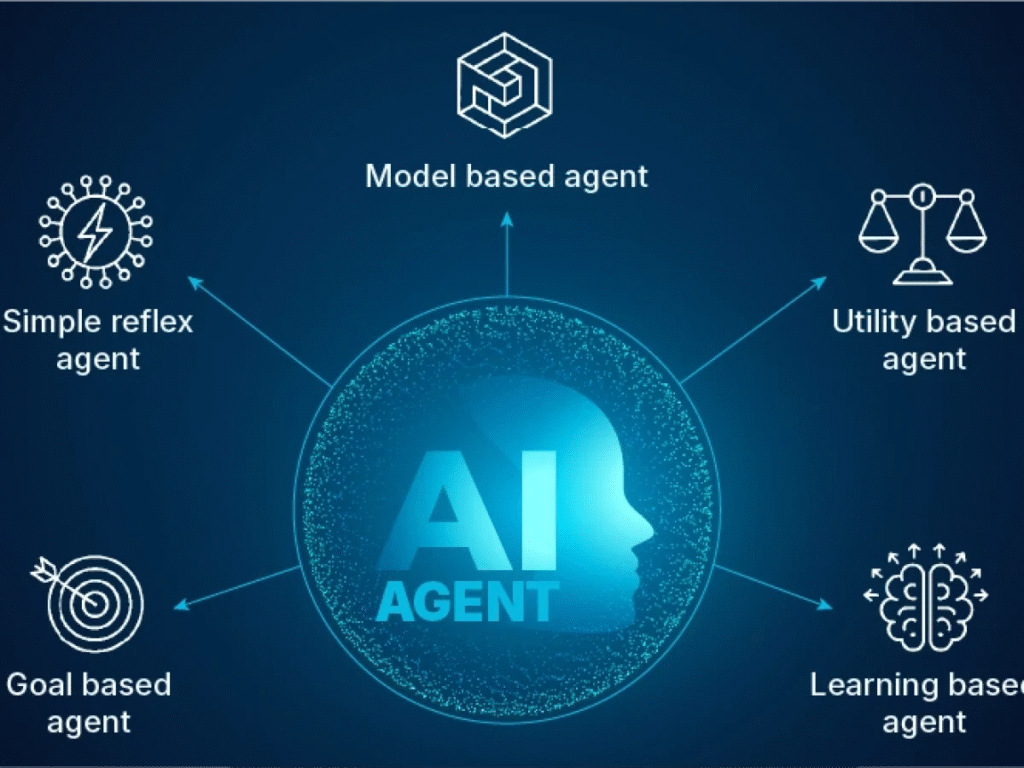
What Are AI Agents?
AI agents are autonomous software systems that use artificial intelligence to observe their environment, make decisions, and execute actions to achieve predetermined objectives. Unlike traditional software that follows rigid programming instructions, AI agents demonstrate reasoning, planning, and memory capabilities with varying degrees of independence. They can process multimodal information including text, voice, video, audio, and code simultaneously, enabling them to engage in complex decision-making processes.
The fundamental architecture of an AI agent consists of four core components:
- Profiling Module: Helps the agent understand its role and gather environmental information
- Memory Module: Stores and retrieves past experiences for continuous learning
- Planning Module: Evaluates situations and selects optimal courses of action
- Action Module: Executes decisions in the real world
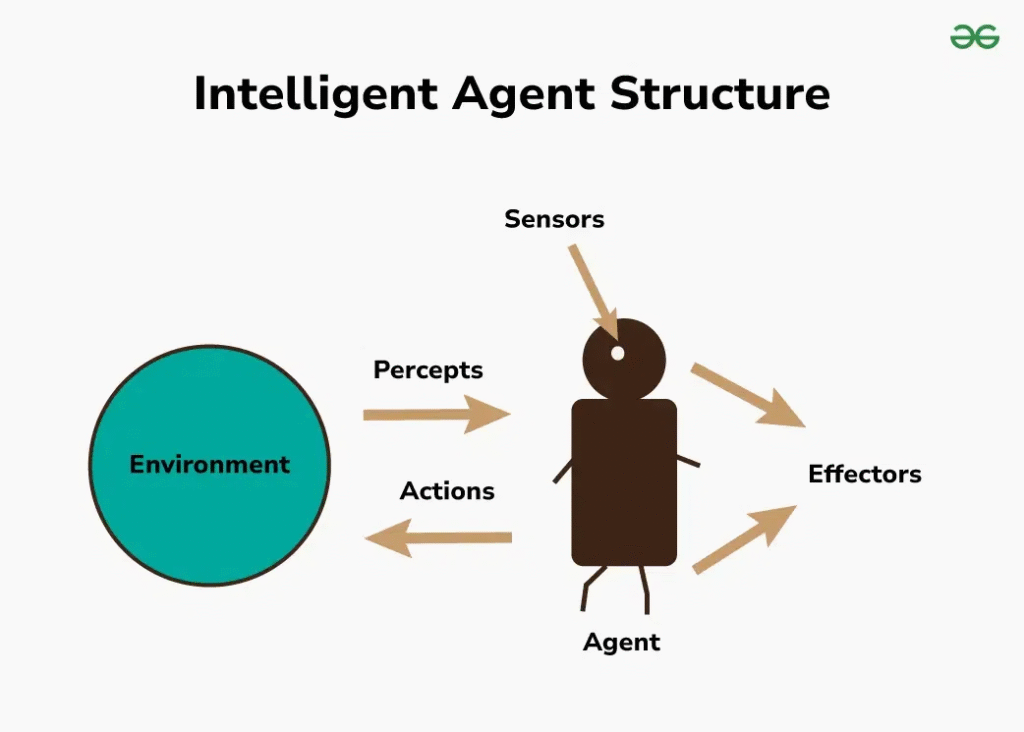
The Seven Primary Type of AI Agents
1. Simple Reflex Agents
Simple reflex agents represent the first type of AI agents, operating on straightforward condition-action rules without memory or learning capabilities. These agents respond immediately to current environmental stimuli using predefined “if-then” logic, making them highly efficient for stable, predictable environments.
Key Characteristics:
- No memory of past states or experiences
- Purely reactive behavior based on immediate input
- Fast response times with minimal computational overhead
- Function best in fully observable environments
Real-World Applications:
- Email automation rules in platforms like HubSpot that tag users based on specific actions
- Motion sensor lighting systems that activate when detecting movement
- Industrial safety sensors that immediately shut down machinery when detecting obstructions
- Basic fraud detection systems that flag transactions meeting predefined risk criteria
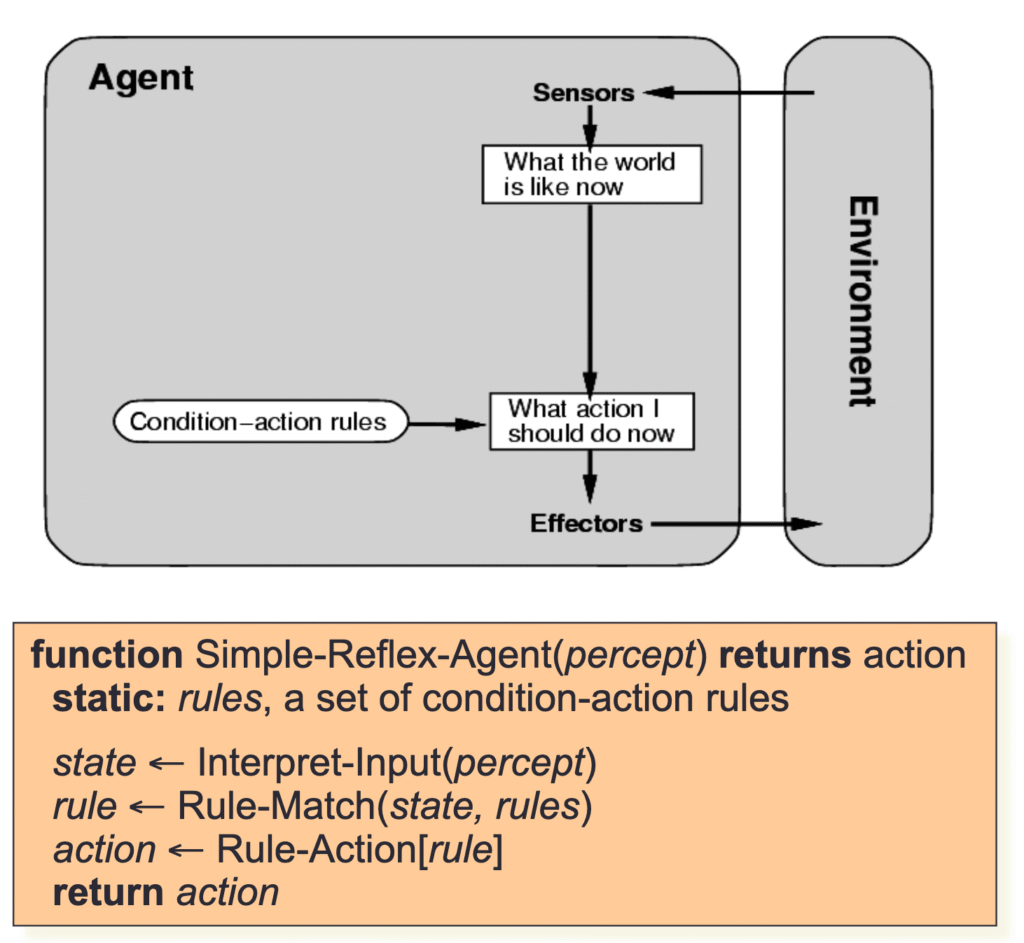
2. Model-Based Reflex Agents
Model-based reflex agents maintain an internal representation of their environment, allowing them to make informed decisions in partially observable situations. These agents track how the world evolves over time and understand how their actions affect the environment, making them more sophisticated than simple reflex agents. This is second type of AI Agent.
Key Features:
- Internal world model for tracking environmental changes
- Ability to infer unobserved aspects of current states
- Enhanced decision-making in dynamic environments
- Memory of relevant past information without full learning capabilities
Business Applications:
- Smart home security systems that learn normal household patterns to distinguish routine events from potential threats
- Self-driving vehicles like Waymo that use detailed maps and real-time sensor data to navigate complex environments
- Network monitoring systems that maintain models of normal operations to detect anomalies
- Robot vacuum cleaners that map rooms and track cleaned areas for optimal coverage
3. Goal-Based Agents
Goal-based agents elevate AI decision-making by focusing on achieving specific objectives rather than simply reacting to stimuli. These agents evaluate multiple possible action sequences and select the path that best advances them toward their defined goals. This is third type of AI Agent.
Core Capabilities:
- Strategic planning and search mechanisms
- Evaluation of actions based on goal contribution
- Consideration of future states and outcomes
- Ability to explore multiple solution paths
Industry Examples:
- GPS navigation systems that calculate optimal routes considering traffic, distance, and time constraints
- Logistics optimization agents that plan efficient delivery routes while managing multiple variables
- Project management AI that allocates resources and schedules tasks to meet project deadlines
- Strategic game AI that plans moves several steps ahead to achieve victory conditions
4. Utility-Based Agents
Utility-based agents represent a sophisticated approach to AI decision-making, employing complex utility functions to maximize desired outcomes across multiple criteria. Unlike goal-based agents that focus on binary success/failure, utility agents evaluate the relative desirability of different outcomes. This is fourth type of AI Agent.
Advanced Features:
- Multi-criteria optimization capabilities
- Quantitative evaluation of action consequences
- Ability to balance competing objectives
- Risk-reward analysis for complex scenarios
Enterprise Applications:
- Financial portfolio management systems that balance risk, return, and diversification factors
- Resource allocation agents in cloud computing that optimize performance, cost, and energy consumption
- Dynamic pricing algorithms in e-commerce that adjust prices based on demand, inventory, and competitor analysis
- Supply chain optimization tools that balance cost, speed, and reliability factors
5. Learning Agents
Learning agents represent the pinnacle of adaptive AI, continuously improving their performance through experience and feedback. These agents can adapt to changing environments, discover new patterns, and refine their decision-making processes over time. This is fifth type of AI Agent.
Learning Components:
- Performance Element: Selects actions based on current knowledge
- Critic: Evaluates agent performance against goals
- Learning Element: Modifies behavior based on feedback
- Problem Generator: Explores new actions for knowledge expansion
Transformative Applications:
- Recommendation engines on platforms like Netflix and Amazon that refine suggestions based on user behavior
- Customer service chatbots that improve response accuracy through interaction history analysis
- Autonomous trading systems that adapt strategies based on market feedback and performance metrics
- Personalized learning platforms that adjust content difficulty and pace based on student progress
6. Hierarchical Agents
Hierarchical agents organize complex tasks through layered management structures, with higher-level agents coordinating multiple specialized sub-agents. This architecture enables efficient task decomposition and parallel processing of complex workflows. This is sixth type of AI Agent.
Structural Benefits:
- Clear task delegation and responsibility chains
- Specialized agents for specific domains
- Scalable architecture for complex operations
- Efficient coordination of multiple processes
Enterprise Implementations:
- Smart factory systems where high-level production agents coordinate machine-level controllers
- Drone delivery networks with central dispatchers managing individual vehicle agents
- Enterprise resource planning systems that coordinate finance, inventory, and production sub-agents
- Autonomous vehicle fleets with route optimization agents directing individual car navigation systems
7. Multi-Agent Systems (MAS)
Multi-agent systems represent the collaborative future of AI, where multiple autonomous agents work together to solve complex problems that exceed individual agent capabilities. These systems demonstrate emergent intelligence through agent interaction and coordination. This is seventh type of AI Agent.
System Types:
- Cooperative Systems: Agents share resources and information for common goals
- Competitive Systems: Agents compete for resources while following defined rules
- Mixed Systems: Combine cooperation and competition elements
- Hierarchical Systems: Implement authority levels among agents
Real-World Impact:
- Supply chain optimization with demand forecasting, inventory, and logistics coordination agents
- Financial trading platforms where multiple agents analyze different market segments
- Smart city traffic management with coordinated traffic light and routing agents
- Healthcare systems coordinating patient care, resource allocation, and scheduling agents
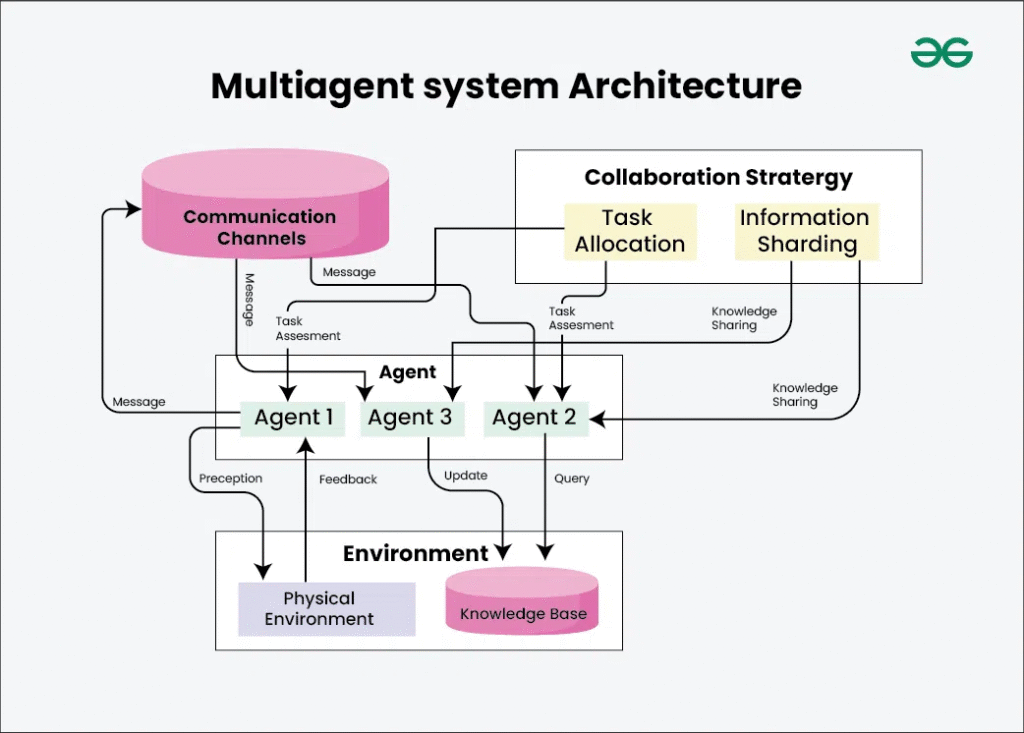
AI Agent Classification by Interaction Model
Reactive vs. Proactive Agents
The distinction between reactive and proactive AI agents represents a fundamental shift in artificial intelligence capabilities. While reactive agents respond to immediate stimuli, proactive agents anticipate future needs and take initiative without direct prompting.
Reactive Agent Characteristics:
- Wait for explicit commands or environmental triggers
- Process current data to respond to present situations
- Follow predefined rules with limited adaptability
- Excel in stable, predictable environments
Proactive Agent Advantages:
- Take initiative based on predictive analytics and learned behavior
- Analyze historical and real-time data to forecast future events
- Prevent problems before they occur
- Optimize outcomes preemptively
Autonomous vs. Assisted Agents
Autonomous agents operate independently with minimal human oversight, capable of planning, prioritizing, and executing multi-step decisions. In contrast, AI assistants collaborate directly with users, requiring human supervision for decision-making.
Industry Applications and Use Cases
Customer Service and Support
AI agents are revolutionizing customer service through 24/7 availability and personalized interactions. Modern conversational AI agents can handle complex queries, maintain context across interactions, and seamlessly escalate issues to human agents when necessary.
Key Benefits:
- Cost Reduction: Chatbots reduce per-query costs from $5-12 to just $1
- Efficiency Gains: 69% improvement in service quality and 55% reduction in wait times
- Scalability: Handle thousands of concurrent conversations across multiple channels
Implementation Examples:
- Best Buy achieved over 60-second reduction in average call time through real-time conversation summaries
- Telefónica handles nearly one million monthly phone calls while supporting 200,000 customer requests via SMS and WhatsApp

Common use cases of conversational AI agents include self-service chatbots, contact center automation, customer engagement automation, conversational commerce automation, and ITSM/HR virtual assistants
Healthcare and Medical Applications
Healthcare AI agents are transforming patient care through predictive diagnostics, remote monitoring, and administrative automation. These agents help healthcare providers deliver personalized care while reducing operational costs and improving patient outcomes.
Clinical Applications:
- Virtual health assistants for appointment scheduling and medication reminders
- Predictive diagnostic systems that analyze medical data for early disease detection
- Remote patient monitoring agents that track vital signs and alert healthcare providers
- Medical research assistants that analyze literature and identify treatment patterns
Financial Services and Banking
Financial institutions leverage AI agents for fraud detection, risk assessment, and customer service automation. These systems process vast amounts of transaction data in real-time, identifying patterns and anomalies that human analysts might miss.
Financial AI Applications:
- Real-time fraud detection systems that flag suspicious transactions instantly
- Robo-advisors providing personalized investment recommendations
- Automated loan processing based on creditworthiness analysis
- Regulatory compliance monitoring for risk management
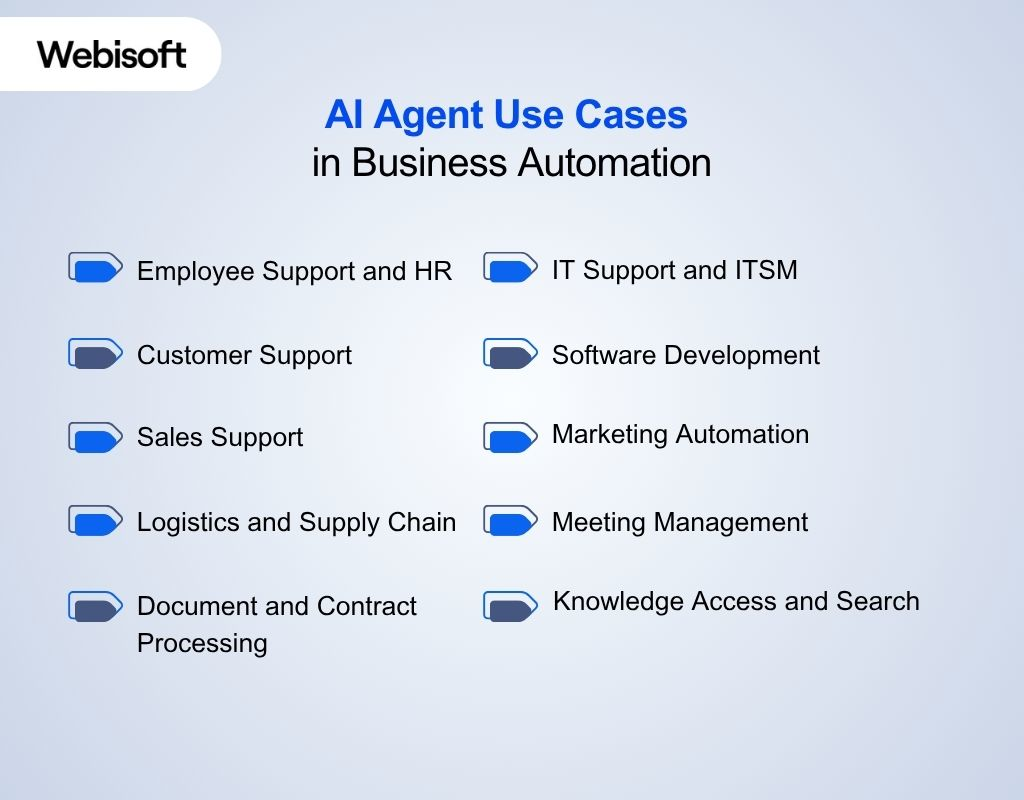
AI agent use cases in business automation include support, development, marketing, logistics, and knowledge management
Manufacturing and Industrial Automation
Manufacturing companies deploy AI agents for predictive maintenance, quality control, and production optimization. These systems monitor equipment health, predict failures, and optimize production schedules to maximize efficiency.
Industrial Applications:
- Predictive maintenance systems that prevent costly equipment failures
- Quality control agents that detect defects in real-time
- Supply chain optimization for inventory and logistics management
- Energy management systems that optimize power consumption across facilities
Technical Architecture and Implementation
Core Components of AI Agents
Modern AI agents integrate multiple technologies to achieve autonomous operation. The fundamental architecture includes:
Deep Learning Architectures:
- Convolutional Neural Networks (CNNs) for image recognition and computer vision
- Recurrent Neural Networks (RNNs) for sequential data processing and time-series analysis
- Transformer Models (GPT, BERT) for natural language processing applications
Decision-Making Frameworks:
- Reinforcement Learning for learning optimal actions through environment interaction
- Multi-Agent Reinforcement Learning for coordinated decision-making
- Probabilistic Reasoning for handling uncertainty and incomplete information
Development Frameworks and Platforms
Several frameworks facilitate AI agent development and deployment:
Popular Development Tools:
- LangGraph for multi-agent system architecture
- CrewAI for collaborative agent workflows
- AutoGen for automated agent generation and coordination
- Google’s Agent Development Kit (ADK) for enterprise-grade agent development
Future Trends and Considerations
Emerging Capabilities
The next generation of type of AI agents incorporates multimodal capabilities, processing text, voice, video, and images simultaneously. These agents demonstrate enhanced emotional understanding and can engage in more natural, human-like interactions.
Advanced Features:
- Streaming video processing for real-time visual understanding
- High-definition voice synthesis with emotional intonation
- Cross-platform integration with 100+ data sources and applications
- Explainable AI for transparent decision-making in regulated industries
Implementation Challenges
Organizations face several considerations when deploying AI agents:
Technical Challenges:
- Resource Management: Multiple agents require significant computing power
- Communication Overhead: Ensuring reliable, low-latency agent coordination
- Integration Complexity: Connecting agents with existing enterprise systems
- Safety and Control: Implementing appropriate guardrails for autonomous operation
Business Considerations:
- Change Management: Training staff to work alongside AI agents
- Data Privacy: Ensuring compliance with regulatory requirements
- ROI Measurement: Quantifying the business impact of agent deployments
- Scalability Planning: Designing systems that can grow with business needs
Conclusion
The landscape of type of AI agents continues to evolve rapidly, offering unprecedented opportunities for business automation and intelligent decision-making. From simple reflex agents handling basic tasks to sophisticated multi-agent systems coordinating complex workflows, each type of AI agent serves specific purposes and offers unique advantages.
Understanding these different types enables organizations to select the appropriate agent architecture for their specific needs—whether implementing basic automation through simple reflex agents or deploying advanced learning systems that continuously adapt and improve. As AI technology advances, the integration of multiple type of AI Agents working in harmony will become increasingly common, creating more powerful and versatile intelligent systems.
The future of AI agents lies in their ability to collaborate, learn, and adapt while maintaining appropriate human oversight. Organizations that successfully implement AI agents today will be better positioned to leverage emerging capabilities and maintain competitive advantages in an increasingly automated business environment.
The key to successful AI agent implementation is matching the right type of agent to specific business requirements, ensuring proper integration with existing systems, and maintaining focus on measurable business outcomes. As these technologies mature, AI agents will become indispensable tools for achieving operational excellence and driving innovation across all industries.
Frequently Asked Questions About Types of AI Agents
Q1: What is an AI agent?
An AI agent is an autonomous software system capable of perceiving its environment, making decisions, and taking actions to achieve specific goals without ongoing human intervention. Unlike regular programs, AI agents can learn, plan, and adapt based on real-time data and past experiences.
Q2: How many type of AI agents are there?
There are typically seven main types: simple reflex agents, model-based reflex agents, goal-based agents, utility-based agents, learning agents, hierarchical agents, and multi-agent systems.
Q3: What is the difference between AI agents and chatbots?
Chatbots usually follow pre-set scripts and can only respond to specific triggers. AI agents, however, have advanced reasoning, planning, learning, and autonomous decision-making capabilities, allowing them to handle more complex tasks and coordinate with other agents over time.
Q4: What are some real-world examples of AI agents?
Examples include self-driving cars, smart thermostats, customer support chatbots, fraud detection systems, and virtual health assistants—all of which autonomously interpret data and make decisions to complete tasks.
Q5: What makes an AI agent “intelligent”?
Intelligent AI agents can perceive context, learn from experience, reason logically, and optimize decisions to achieve goals efficiently. They adapt their actions over time to improve outcomes, rather than just execute hard-coded instructions.
Q6: How do simple reflex agents differ from model-based reflex agents?
- Simple reflex agents base decisions only on the current input, using condition-action rules and no memory.
- Model-based reflex agents maintain a representation of the environment, enabling them to handle partially observable environments based on experience and inference.
Q7: Can AI agents operate in hierarchical or collaborative structures?
Yes. Hierarchical agents use layered architectures for complex tasks and increased scalability, while multi-agent systems involve multiple agents working cooperatively or competitively to solve bigger problems.
Q8: What are the key benefits of using AI agents in business?
Key benefits include increased efficiency, improved accuracy, scalability, adaptability, and enhanced decision-making—helping businesses automate repetitive tasks, optimize processes, and deliver personalized user experiences.
Q9: What kinds of tasks are AI agents best suited for?
AI agents excel at automating workflows, data analysis, predicting outcomes, customer service, supply chain management, and handling dynamic environments where reasoning and learning are valuable.
Q10: Is ChatGPT an AI agent?
ChatGPT can be considered an AI agent when deployed to process input, generate meaningful responses, and perform tasks such as information retrieval or routing decisions, especially if it learns and adapts as part of its workflow.
Q11: What challenges do AI agents face?
Common challenges are dealing with dynamic environments, ensuring accurate data input, handling infinite loops, overfitting, and the need for robust planning and utility functions. Emotional intelligence and empathy are still limited in most AI agents.
Q12: How do AI agents interact with the environment?
AI agents use sensors to gather data and actuators to execute decisions. Their architecture includes perception, memory, planning, and action modules for robust interaction.
Q13: How do learning agents improve over time?
Learning agents refine performance by processing feedback from their actions, modifying their strategy, and exploring new approaches through dedicated learning, problem-generating, and critic modules.
Q14: Can AI agents work together?
Yes, AI agents can collaborate in multi-agent systems or communicate hierarchically, allowing for advanced problem-solving, resource sharing, and coordinated decision-making in complex environments.
Q15: Where is the future of AI agent technology headed?
AI agents are evolving to handle multimodal inputs, demonstrate more proactive behaviors, integrate across platforms, support explainable decision-making, and function seamlessly in dynamic, real-world environments.
